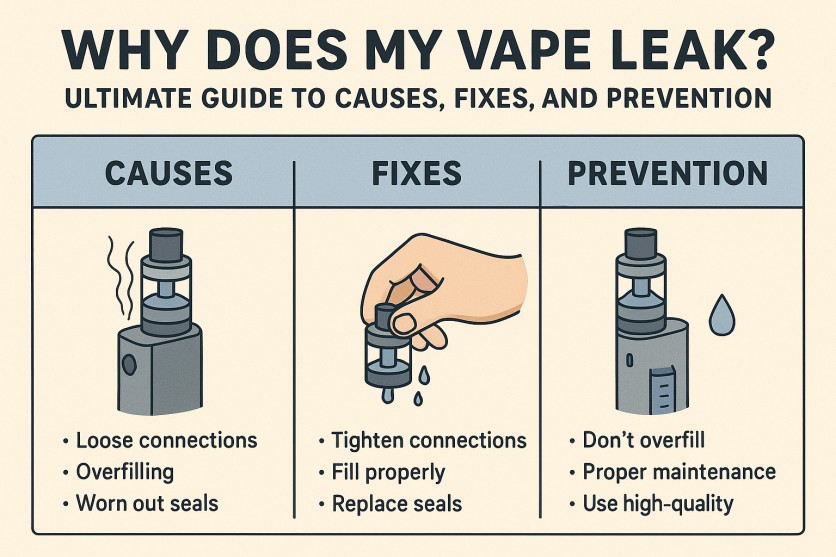
ARE YOU OF LEGAL VAPE AGE?
Please confirm that you are of legal age to purchase vaping products to access our site.

Please confirm that you are of legal age to purchase vaping products to access our site.
Some items are no longer available. Your cart has been updated.
This discount code cannot be used in conjunction with other promotional or discounted offer.
Vape leaking is a common frustration for many e-cigarette users, often leading to messy experiences and wasted e-liquid. If you've ever wondered, "Why does my vape leak?" or "How to fix a leaking vape pod?", you're not alone. This comprehensive guide dives into the scientific reasons behind vape leaks, safety concerns, repair steps, and proven prevention strategies. Whether you're a beginner or seasoned vaper, understanding these factors can help you enjoy a leak-free vaping experience.

Vape leaks can stem from various issues, including design flaws, physical forces, chemical reactions, and user habits. By addressing these, manufacturers and users can significantly reduce occurrences. Let's explore the root causes in detail.
E-liquid in vapes primarily consists of propylene glycol (PG), vegetable glycerin (VG), and nicotine mixtures, with surface tension highly sensitive to temperature changes. Uneven heating in the atomizer can cause localized high temperatures, reducing liquid surface tension and allowing e-liquid to breach seals. If the sealing structure isn't designed for varying e-liquid viscosities, leaks can occur after continuous use as the e-liquid heats up.
Atomizer cores often use porous ceramics or cotton fibers with pore diameters ranging from 10-50μm. High porosity or uneven pore distribution can disrupt capillary action during negative pressure draws, allowing e-liquid to pass through the core into the airflow path. Ceramic heating elements may have inconsistent pore sizes—some too small for effective wicking, others too large for proper liquid retention—leading to leaks.
According to Bernoulli's principle, drawing on a vape creates a 500-1000Pa pressure difference inside and outside the atomizer chamber. If O-rings age (hardness exceeding 70° Shore A) or assembly tolerances exceed 0.1mm, this pressure combined with capillary forces can force e-liquid through gaps. This is especially common during hard draws.
E-liquid has a volume expansion coefficient of about 0.0007/°C. The temperature difference between operating (200-280°C) and room temperature (25°C) can cause up to 15.7% volume expansion, exceeding tank capacity and causing overflows. While less common during use, this becomes problematic in high-heat storage (e.g., a car in summer reaching 60°C+), where prolonged exposure leads to air and component expansion, slowly forcing e-liquid out via pressure and capillary action. Storage leaks are harder to solve than usage leaks.
The polarity difference between propylene glycol (dielectric constant 32) and glycerin (42.5) can lead to phase separation in mixtures, especially after long periods of stillness. Lower-polarity components more easily penetrate sealing materials.
Flavor molecules like menthol (molecular weight 150-300Da) can cause swelling in silicone O-rings, reducing contact angles from 110° to 80° and compromising seals. Swelling not only alters angles but also disrupts sealing integrity, allowing leaks. Many vapers notice this in transparent tanks: unused devices show silicone swelling from white opaque to milky translucent. This poses safety risks, as non-food-grade silicone may leach substances into e-liquid— a critical issue needing attention.
In direct-to-lung (DTL) or hard draws, high negative pressure in the airway can exceed the core's liquid-locking threshold (worse in cotton cores), pulling unatomized e-liquid into the airflow and mouth. This mismatch between core design and draw pressure causes usage leaks.
Everyday handling, like fiddling or tapping vapes on surfaces, can destabilize poorly designed structures, leading to seal failures and leaks. Random vibrations from carrying during movement create liquid fluctuations; excessive amplitude can cause impact-induced leaks, though this isn't the primary cause.
The analysis shows vape leaking as a multifaceted issue involving fluids, heat transfer, structures, and materials. Solving it requires a multi-disciplinary approach.
A frequent question among vapers is whether it's safe to continue using a leaking pod. Here's what you need to know:
For peace of mind, consider switching to a new pod or consulting a professional to avoid potential health and device issues.
If your vape is leaking, follow these steps to troubleshoot and repair:
These steps can often resolve leaks quickly, saving your device and e-liquid.
Prevent future leaks by adopting these best practices for storage, maintenance, and e-liquid selection:
Proactive measures and attention to detail are key to preventing vape pod leaks. Here's how:
Proper Pod Maintenance
Correct Assembly Techniques
Temperature and Environmental Considerations
Choosing Quality Products
Vape leaking doesn't have to ruin your experience. By understanding causes like surface tension issues, pressure differences, and chemical reactions, you can take informed steps to fix and prevent them. Prioritize quality products, regular maintenance, and safe handling. If leaks persist, consult professionals or explore warranty options. Ready to upgrade your setup? Check out reliable VAPEPIE vape brands for leak-resistant designs and start enjoying hassle-free vaping today! If you have more questions on "how to fix leaking vape" or prevention tips, feel free to ask.
First, don’t worry. While the taste of leaked e-liquid in your mouth is unpleasant, simply brushing your teeth and rinsing your mouth is enough. It generally won’t cause any serious harm.
That said, choosing the right vape device is very important. For example, the popular VAPEPIE 40000 and VAPEPIE 70000 are designed with leak-proof technology. Compared to many other brands, they perform much better and are also more affordable.
Tips to Prevent Leaking:
Hope this helps!

Comment